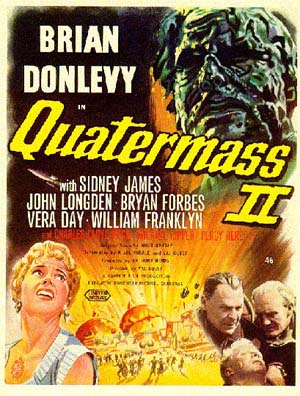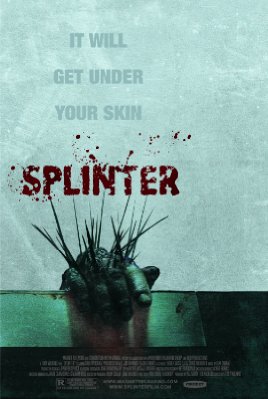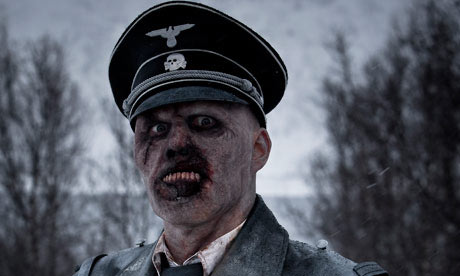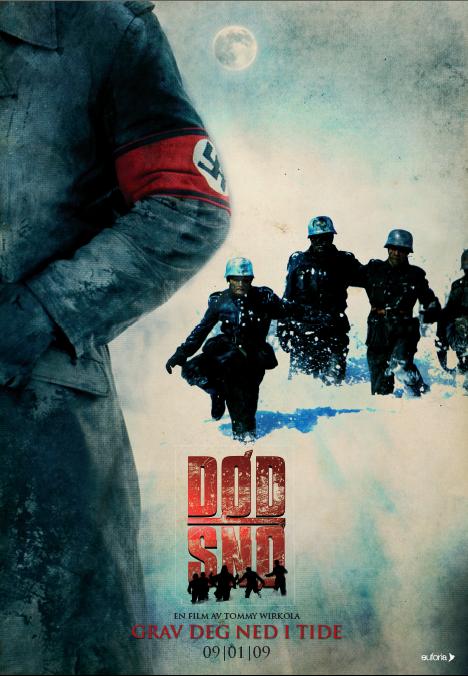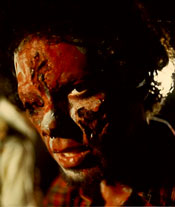It's June, which means that 41 years ago,
Night of the Living Dead is supposed to have taken place. Today we look at two independent zombie films that don't have much to do with each other. For the time it took for me to learn about this first film, I blame American distributors of DVDs.
Zombie Diaries, in case you’re wondering where you’ve heard the name before, is the british film that beat George A. Romero to the reality TV zombie film punch before he could release his
Diary of the Dead on roughly the same subject. The difference, the big difference I should say, is that Romero’s film has characters and that
Zombie Diaries has people. It’s like the difference between watching a John Sayles film and a Wachowski Brothers film, if that means anything to you. Anyway, the first of the reality zombie films, by all accounts, is a really excellent film because it manages to craft a taut murder story in its down time and both pay tribute to and show up George Romero at the same time.
Zombie Diaries
by Michael Bartlett & Kevin Gates

Our framing story concerns a military unit swarming a building while someone films them. They find a body and there is concern about whether or not its actually dead. Then we start ‘diary’ 1. A camera crew and one anchorwoman are roving about collecting interviews concerning an epidemic of some kind going on in Asia. Nobody in particular is bowled over by the crisis and they plan to go about their daily lives as usual. When the interviews stop, the cameraman starts filming the crew candidly. They go into the studio and a higher-up informs them that New York has just been hit by the epidemic. They don’t have much time to react before they get sent to a little town to conduct an interview with a farmer who’s just been asked by the government to kill all his chickens preemptively; infection is a tricky thing. So they get there and not only does the farmer not come to the door but the entire town seems deserted. They make to leave but their car breaks down; when the producer calls for help when no one in the village seems to be around to help them, he’s told that London has just been hit and that they’re on their own. With darkness approaching, they head back to the farm and confirm the suspicions zombie fans will have had since that poor sucker failed to come to the door; the infection’s hit this small town in a big way. They barely escape into the woods with their lives.
Just as we’re told that they seem to have all survived the attack on the farmhouse, we shift to diary 2. Three people; two active, one holding the camera, enter a small town looking for supplies, killing zombies with a stolen rifle. This segment is a little less memorable and a little more trying because the cameraman feels the need to say what everyone always says in modern zombie films “everything’s dead, what a bummer. How ironic that I spent my life doing X.” Yeah, we've all got problems, pal. Their story comes to no real conclusion, other than to say they’re probably ok before it’s on to diary 3.

Diary 3 is the last and longest of them and is also the one with the most kick to it. A pretty decently sized group of survivors lives in a house in a field away from most life. There are scattered old industrial buildings about, but its mostly woods around (in other words Romero country, British style). Everyone’s in a bit of a huff because the new guy, Goke, is a real hothead. Well he takes his name from a film about an alien who cuts faces open so he can steal bodies, I guess I’d be a little apprehensive about spending time alone with him, too. Things look pretty bleak for these guys; they bicker a lot, three of them get killed during a mission for supplies (all of it is filmed, of course; shockingly, one of them is mistaken for a zombie and shot dead while laughing maniacally at his infected wounds). Where things get really interesting is when two of the survivors go into one of those old warehouse-type buildings on the edge of the woods for supplies. The cameraman tells his friend that Goke was supposed to secure the building yesterday, but he didn’t look in after him. They find a female zombie handcuffed to a wall, naked. This, we’re assured, will not stand. Unfortunately, Goke is a bit more accustomed to shooting first, as some footage from a month earlier tells us, when he and a friend encountered the group from diary 1 just after their escape from the farm house.
I like films with more than one problem.
Zombie Diaries gives us not just the ultimate crisis situation, but puts two believably crazy killers in the mix. There are people like that out there and I just know that those assholes would survive the apocalypse. That’s why the law of averages is a dick. And the best part is when we see them trying to assimilate themselves into groups of normal folk, already at wit’s end, just emanating sleaziness. The performances, by our killers and everyone else, are all excellent. I don’t know if it’s just the British accent but something about low budget English films makes them work better than low budget American films. The people in British films just seem more believable for some reason. I guess because I grew up witnessing bad acting done in wretched American accents I’m more aware of what bad acting looks and sounds like when Americans are doing it. In all fairness the people in this film could be acting poorly, but maybe I wouldn’t know it. The only thing I didn’t like were the monologues delivered in act II, but that was more an issue of writing, not delivery. I liked the performances, by and large. It’s tough to reasonably capture that end of the world moodiness, but everyone does a really good job acting naturally, which I can't say for
Diary of the Dead which was more an exercise in Romero trying to emulate the voice of a teenager than really capturing someone's voice. I give Romero a pass, though, because there are people who are making great films using his movies as a template;
Zombie Diaries is one such film.
The camera work is all really nicely done and of all the reality zombies I’ve seen, this one had the best post-production. What I mean is that when things get bad in the film and the camera may in reality experience some difficulties, the feed gets splotchy, the picture jumps, lines run up and down the screen, etc. It looks like real footage, and they went through a good deal of work to make sure it looked like the real thing. The zombies themselves look great, the first two we see especially. The first of the film’s scares comes when we meet our first shamblers in the bedroom of the farmer’s house; her white eyes and undead moaning are really good. Sometimes it doesn’t matter how many times you’ve seen the same thing; sometimes scary is just scary. Which is why zombie films may be around until we figure out a way to bring zombies around for real.

So we have decent camera work, excellent performances, believable dialogue, decent effects, a really great use of a three act structure, and no ego to speak of. Not bad for a film that took two years to make its way to the US. Compare that to an independent film made for even less money in the states and it shows our reluctance to accept foreign things. This movie, of course, has an edge, as it’s been accepted into the vast network of H.P. Lovecraft related material. Lovecrafties, man, they’re worse than trekkies. I’m being facetious, but still, this thing hasn’t been even remotely hard to find since it got released in 1999. I’m just saying…we could try harder, people.
Cool Air
by Brian Moore

A young man, Randolph Carter, moves into a cheap apartment building beneath an exiled professor called Muñoz. Muñoz is a queer chap indeed. Carter hears strange things about him from his landlady and one day some odd fluid starts pouring into his apartment from the room upstairs. Carter has a heartattack soon enough afterwards to invite suspicion about the nature of the spill and when he wakes up he’s in Muñoz’s flat. The first thing he notices about the Muñoz place is that it’s freezing; the old man has kept the place at a cool 56 degree temperature. Muñoz is also a gifted physician; he did after all, save Carter from certain death. Naturally our young hero has some questions: what was that liquid? Why are you living alone? And why on earth is it so cold in here? Carter’s about to be very sorry he asked.
Muñoz used to be a big deal in the scientific community until a horrible accident. He now lives alone using his ammonia cooling system powered by a gas engine to see that his health remains stable. What health condition is aided by the installation of a perpetual cold machine? What happens when it stops making things cold? I don’t think I’m ruining a thing when I tell you the doctor is in fact undead and has been for almost twenty years. The cold was just one in a continuing series of temporary solutions to stop him from decaying.
Ok, history lesson:
Cool Air is by all accounts the western world’s first exposure to the living dead. Did you hear what I said? That’s a big deal! I except
Frankenstein and
Dracula and other vampirey type films in this estimation because we’re dealing with three different paradigms here. The Frankenstein monster is made of other folks and needed a lot of assistance from our old friend science before he could get up and raise hell, so he’s not a zombie. A vampire still talks and throws dinner parties and stuff, so we all know he ain’t a zombie. I’m talkin’ a guy who stopped living and then came back to life unaided by the occult. The first time we had one of those was in a short story by that master of the macabre H.P. Lovecraft.
Cool Air, the movie,
was made by a devout fan of Lovecraft. How do I know this? Cause the movie’s script is the short story verbatim, that's how!
 Cool Air
Cool Air is a fine homage to the work of H.P. Lovecraft as its existence is predicated entirely upon the words of Howard P. The problem with this is that the film has no personality, pretty poor acting, very amateurish 16mm cinematography, and a pretty hollow looking California location instead of the original New York setting. It’s unremarkable in just about every way were it not for the fact that it is to date the most successful and important adaptation of the very first zombie story ever published in the English speaking world. I don’t know that that means we forgive it’s shortcomings, which are many, but I do know one thing: a film like this will almost always have an audience despite its being stagey, talkey, and boring.
Zombie Diaries, which I really enjoyed, almost didn’t make it across the Atlantic Ocean into my video store. I think we need to open a dialogue about artistic merit in this country and quick because I can still feel the hot breath of the
Friday The 13th remake on my neck.
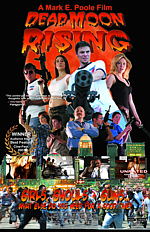 The only difference between this and your average student zombie film is ther's a snarky narrator telling us things we could care less about. The economy, the weather, a bunch of other shit no one cares about, least of all in a movie that was a total misuse of funds. There's a scene at the end where a lot of extras, most of them bikers, and a lot of zombie extras clash on some Californian street or other. If you had the money to get those people together and close a street down, you had the money for a better camera or a decent idea.
The only difference between this and your average student zombie film is ther's a snarky narrator telling us things we could care less about. The economy, the weather, a bunch of other shit no one cares about, least of all in a movie that was a total misuse of funds. There's a scene at the end where a lot of extras, most of them bikers, and a lot of zombie extras clash on some Californian street or other. If you had the money to get those people together and close a street down, you had the money for a better camera or a decent idea. There's a tendency in a lot of Spanish and/or Latin American pop culture to base stories around guys in black trench coats shooting enormous guns. That's not really all that interesting. Now add a lame sense of humour, subtract continuity, add some dime budget zombies, and shoot it all in video and you have Deadhunter. I wish there was more to say, but there isn't. No one involved has apparently fired one of those giant guns they're carrying because they misuse them left and right.
There's a tendency in a lot of Spanish and/or Latin American pop culture to base stories around guys in black trench coats shooting enormous guns. That's not really all that interesting. Now add a lame sense of humour, subtract continuity, add some dime budget zombies, and shoot it all in video and you have Deadhunter. I wish there was more to say, but there isn't. No one involved has apparently fired one of those giant guns they're carrying because they misuse them left and right.
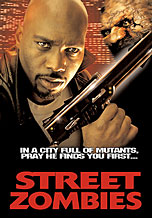 I had high hopes for Bookwalter after his misguided but grimy low-budget The Dead Next Door. That wasn't a great film, but it had some pretty decent gore effects and a pretty unique idea so I don't think I was the only one who maybe thought Bookwalter would make something of himself. Ozone was his last zombie movie before becoming a part of Full Moon Pictures and Tempe Video's stable of terrible directors dedicated to straight-to-video horror films that cost less than most weddings. Anyway, back to Ozone. Ozone is supposed to a police procedural/zombie film crossover, but unless you really like being bored out of your fucking mind, you'd never know it. Anyway, the zombies are in service to a big, fat drug-fueled zombie. None of it makes any sense and the zombies are just kinda there and do whatever suits the scene; continuity was not Bookwalter's specialty.
I had high hopes for Bookwalter after his misguided but grimy low-budget The Dead Next Door. That wasn't a great film, but it had some pretty decent gore effects and a pretty unique idea so I don't think I was the only one who maybe thought Bookwalter would make something of himself. Ozone was his last zombie movie before becoming a part of Full Moon Pictures and Tempe Video's stable of terrible directors dedicated to straight-to-video horror films that cost less than most weddings. Anyway, back to Ozone. Ozone is supposed to a police procedural/zombie film crossover, but unless you really like being bored out of your fucking mind, you'd never know it. Anyway, the zombies are in service to a big, fat drug-fueled zombie. None of it makes any sense and the zombies are just kinda there and do whatever suits the scene; continuity was not Bookwalter's specialty.




